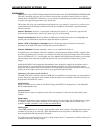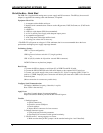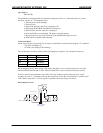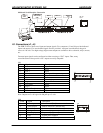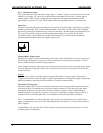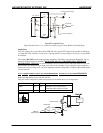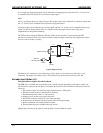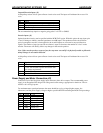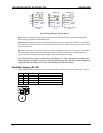
ADVANCED MICRO SYSTEMS, INC. HARDWARE
6
“Do’s, Don’ts and Important Notes”
• NEVER connect or disconnect motor wires while power is supplied.
• When using a 6 lead motor be sure to insulate/isolate unused wires.
• The physical direction of the motor with respect to the direction input will depend on the
connection of the motor windings. To reverse the direction of the motor with respect to the
direction input, switch the wires on phase 1 or phase 2 of the outputs.
**************** WARNING ********************
LIVE CONNECTING/DISCONNECTING MOTORS WILL CAUSE DAMAGE THAT IS NOT COVERED BY
WARRANTY.
Serial Interface (J2, J3)
Two (RJ-45) connectors provide a loop-through connection, facilitating multiple axis systems. This “mini-
drop” network allows for a single ASCII character “name” to be assigned and stored in the integral non-
volatile memory of each axis during the setup procedure.
J2 J3
Pin Signal Comment Pin Signal Comment
1 J2-1 Not used 1 J3-1 Not used
2 GND Power Gnd 2 GND Power Gnd
3 RX- +Data in 3 RX- +Data in
4 TX- +Data out 4 TX- +Data out
5 TX+ -Data out 5 TX+ -Data out
6 RX+ -Data in 6 RX+ -Data in
7 5V Power for serial adapter 7 N/C Not used
8 Party Enable party line or single 8 Party Enable party line or single
All signals on J2 and J3 are interconnected; the 5-volt power is only supplied to J2 – 7. The 5-volts is
intended to power an AMS serial adapter.
There are three types of serial adaptors available.
1. SIN-7 (DB-25), SIN-9 (DB-9). These are passive adapters that allow a basic RS-232 interconnect,
suitable for single axis usage. Party line is not possible with the SIN-7 or SIN-9. Daisy chain
protocol is possible but not recommended.
2. SIN-8 (DB-25) includes an RS-232 to RS-422 converter. A switch selects single or party line mode
for up to 32 axes (includes terminator plug). Proper handshake must be implemented in your
computer for successful party line operation.
3. SIN-10 (DB-9) is a microprocessor-based adaptor that features a dual UART, RS-232 to RS-422
converter at different baud rates and character buffers. The necessary handshake is built in, thus
the sometimes expensive and time-consuming software interface is avoided. The serial
communications is full duplex at 9600 baud. Operation at special 470k baud is possible.
If you have not chosen the SIN-10, the proper handshake MUST be implemented in the host computer to
avoid loss of characters. This protocol is “echoed” characters. If your operating system or application
software is not capable of character-by-character transmission, a SIN-10 is probably necessary. If system
production cost is the priority, the additional system programming effort to implement a SIN-7, 8 or 9 may be
cost effective. A complete description of the serial interface specifications and operation is contained in
Section 2, “Serial Interface.”






